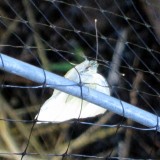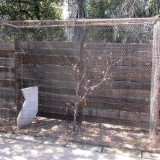It’s come to this: Vegetable San Quentin. Last year’s Crittercam surveillance project demonstrated the futility of planting vegetables in our yard without serious fortifications. Bird netting? Useless. If we want to grow our own veggies we had to build something that can resist the strong arms and fingers of our local band of late night hipster raccoons.
Once again, I can’t say enough good things about the usefulness of the free 3d drawing program Sketchup, which I used to plan out my veggie prison. It was especially useful for figuring out the angles of the cuts I needed to make for the top. I was able to dial in those angles and dimensions on my compound miter saw. All that was left to do was screw the whole thing together and staple the 14-Guage welded wire from Home Despot.
The access panels have two positions. Down to protect small seedlings:

And up to act as a trellis and allow tall plants to grow out the top:

I’ve noticed that once plants get established and past the 2-foot point I don’t usually have to worry about those midnight raccoon parties. Obviously, if I had to deal with deer I’d have to build a bigger cage. I can also cover the whole thing in floating row cover material if I want to keep out cabbage leaf caterpillars.
If you’re a Sketchup user I uploaded the plans to the 3D Warehouse. Search for “Raccoon Proof Vegetable Bed” and you’ll be able to download it. This bed was designed for the narrow top slope of our front yard and is 3 by 8-feet. I would recommend increasing the width to 4-feet if you build one yourself.







Hey, I call it Home Despot too!
Glad someone caught that joke. I do try to use our local hardware store but they don’t have everything.
Looks beautiful! My only concern is that the welded wire will leave room for critters to reach inside. This can be a problem for chicken coops, so I generally recommend 1/4″ hardware cloth instead. I’ll be curious to hear how the welded wire works out in this application. Also: I’m curious if you did anything to weather-proof the wood. Either way, nice work!
Definitely true for chicken coops. I used 1/2 hardware cloth for my coop. In this case, I don’t think reaching in will be a problem but I’ll let you all know.
That prison is not secure. Raccoons can reach inside. They have very long front “arms” and are strong. Use a smaller size, like 1/2 inch. Of course, it you use 1/4 inch rodents won’t get through. Okay, maybe some will but not rats.
If you use the welded wire, make sure it is not GBW–galvanized before welding. GAW–galvanized after welding is the best–galvanized after welding. I always use GAW even though it costs a bit more.
http://www.louispage.com/blog/bid/7512/Galvanized-Before-vs-Galvanized-After-Mesh-Fence
Plus, raccoons can turn it over. They can move aside cinder blocks.
Thanks for the tip PP. We’ll see if they reach inside–judging from the videos I shot of them with the critter cam the main problem was them digging for grubs and wrestling with each other! I think my wire will work but I’ll let everyone know if it doesn’t.
I have very good luck keeping racoons, cats, and chickens out of our vegetable beds using that same stuff for side panels. We just have posts at the four corners of the beds with cleats on them to hang the wire panels. The only time the racoons jump the side panels at our place is when I put in new compost filled with worms. So I place a panel on top of the beds in those instances. Our neighborhood racoons have not yet been industrious enough to reach through or remove any of the panels, even though they surely could if they gave it some thought.
Pamina–thanks for your comment. I’ll report back if I have a failure.
That looks really good. With glass or plastic it could be used as a mini-greenhouse.
My thought too–could also cover it with row cover material.
Lovely! It’s much more robust than my anti-rabbit solution – just a thin square of wood that sits on the bed edges, with a wall of chicken wire rising about 2 feet from it. (the wire is stiff enough that it stands up, though it’s not particularly aesthetically pleasing.) When I newly seed something I put bird netting on the top to keep birds out.
No raccoons, yet, thank goodness. They’re not native to Germany, but the news say they’re here and on their way to this state. At least they eat rabbits…?
We had the exact same problem in our neck of the Silver Lake hills. The bandits dug up most of our home-sprouted seedlings looking for grubs. Our solution was far less elegant, however, involving copious amounts of chicken wire, with over-arching PVC ribs, over our 3’x6′ box. So far so good, though!
Pingback: How to Design and Fabricate Homestead Projects | Root Simple
My backyard is a war zone. I wound up pouring cement footers with PVC pipe inserted every 6 feet for metal fence poles. After the 2×4 inch deer fence was installed I put in a lower 1×1 inch galvanized rodent fence secured at the bottom on both sides with pressure treated timbers. These were gorilla glued and anchor shot into the footers then screwed together. The top wire has an additional wire of 5 and 3 inch spikes that go in all directions and then down the inside are horizontal spring spirals (recycled from a King sized mattress) with Marrion berry vines spreading across the fencing and anchoring themselves through the springs.
This looks great to me…but I have zero experience with raccoons! I look forward to hearing how it all turns out!
According to some scientifically inclined folks, we learn by something called Prediction Error. Evidently, we have a reward processing system in our brain. When something unexpected happens that constitutes an error in our prediction abilities- I guess we predict nothing new is going to happen in our prediction resting state. Anyway, a chemical reward is issued to us which makes us have that “Aha!” moment and causes us to learn something new. We learn through surprise. Gardens, and the observing of nature seems to cause a lot of Aha! moments. We also learn what lead up to that “aha” moment through temporal difference learning, which is figuring out the sequence of events that led up to the learned experience over time which reinforces the learned experience. We need to learn over and over again. Eventually, once we know the sequence of events our brains stop issuing reward stimuli. But with gardening, this can take a lifetime because gardening is seasonal so reinforcement is slower. Blogs like this can speed up our learning reinforcement- we readers getting bit of reward brain candy vicariously through your prediction errors- thanks for all the dopamine, kids!- as we all trudge the garden path to happiness via our communally shared mistakes.
Looks nice! I hope the staples are long and secure enough to prevent the fence from getting pulled off.
I think it will probably work fine, but in case it doesn’t, will you upgrade from a San Quentin to an Alcatraz? (i.e., surround your garden with a shark-infested moat?)